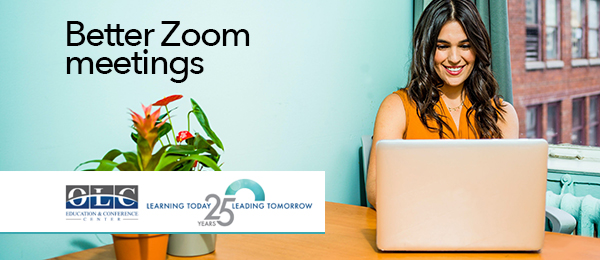
Best Practices for a Successful Zoom Meeting
Chances are, by this point you’ve probably attended or even hosted a virtual meeting. Whether you use Zoom, Skype or any other number of video conference platforms, there is much more to know than just how to join the meeting. We’ve compiled some best practice advice, expert opinions and yes, even some funny tips, to help optimize your virtual experience.
Don’t let your background be the first thing people notice
- This may sound obvious but try to avoid sitting with your back to a window. The lighting in this scenario is not ideal and you could end up looking uneven, or worse, like a shadow or silhouette. Soft overhead lighting or small desk lamps typically work best.
- When you are on video, you want participants focused on you and not what’s behind you. Many people like to take video calls in front of a bookshelf. If this your preference, choose what books are displayed with caution. The funny book series your Great Aunt sent for your last birthday might not be appropriate during business meetings. What about the group photo from spring break in Cancun? Probably a good idea to remove it from the shelf.
Mute works for audio and not video
- Mute works great when you need to cough, type a quick email or wait for your turn to present. It’s important to remember that mute does not pause your video. When you are muted on a video call, you can still be seen. Now is not the time to feed the dog or get your jumping jacks in.
- On the opposite spectrum, remember to click the microphone on the bottom left-hand corner to unmute yourself. It’s never fun to present a groundbreaking idea and then realize you were on mute the entire time.
Screen over-sharing
Screen sharing is one of the key features that Zoom does very well. You can share your entire desktop, specific application windows, a whiteboard or just a portion of your screen. This is a great option for PowerPoint presentations. However, once you are done, do not forget to “stop share” in the meeting controls. We’ve all probably been known to multitask during meetings sometimes. The last thing you want is to continue sharing your screen while you are answering emails or editing your Amazon shopping cart.
What about security?
You’ve probably heard a few stories where some uninvited guests showed up on a Zoom call. One of the best ways to secure a meeting is to utilize Zoom’s Waiting Room feature. On a recent company webinar, Zoom Chief Information Security Officer Jason Lee provided a review of useful features you can use to secure your meetings. Leveraging tools in the pre-meeting settings to ensure meetings are secure from the outset, such as enabling Waiting Rooms, Passcodes and the Join by Domain feature, are simple things that can make a significant difference.
Zoom Burnout is real
If you’re working from home, without a commute, you might be wondering why you still feel so tired all the time. CBC News recently covered a story on how video chat meetings are draining users more than in-person conversations. Psychologist Janine Hubbard says, ‘Zoom fatigue’ is a real phenomenon and “is affecting people as they spend more time on the videoconferencing platform.” Some of the exhaustion people are experiencing can be attributed to a different type of focus and attention that is required for virtual calls. Add to that, the stress of being constantly watched on camera, and it becomes obvious how burnout can occur. Some recommendations to combat this:
- Spend some time away from the screen to stay energized.
- Use your breaks to take a brisk walk and get some fresh air.
- Have various options for where to participate in your video calls.
We would love to hear your best Zoom stories or your own tips for meeting success. And if you’re looking for a change in environment or a more professional way to stream your video conference calls, we’re here to help. Contact the OLC to plan a customized event.

